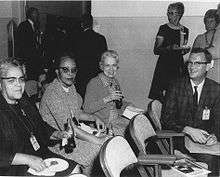Dorothy Vaughan
| Dorothy Vaughan | |
|---|---|
 Sitting, left to right: Dorothy Vaughan, Leslie Hunter, Vivian Adair, standing in the background: Margaret Ridenhour, Charlotte Craidon [1] | |
| Born |
Dorothy Johnson September 20, 1910 Kansas City, Missouri, United States |
| Died |
November 10, 2008 (aged 98) Hampton, Virginia United States |
| Nationality | American |
| Fields | Mathematics |
| Institutions | NACA, Langley Research Center |
| Alma mater | Wilberforce University, 1929 |
Dorothy Johnson Vaughan (September 20, 1910 – November 10, 2008) was an African American mathematician who worked at the National Advisory Committee for Aeronautics (NACA), the predecessor agency to NASA.
Life and career
She was born Dorothy Johnson in Kansas City, Missouri, the daughter of Annie and Leonard Johnson. Her family moved to Virginia and she graduated from Wilberforce University in Ohio. Dorothy married Howard Vaughan in 1932 and the couple had four children.[2]
Prior to arriving at NACA's Langley Memorial Aeronautical Laboratory in 1943, Vaughan worked as a mathematics teacher at R.R. Moton High School in Farmville, Virginia.[3] Dorothy Vaughan’s career at Langley spanned twenty-eight years. Hired in 1943 and assigned to the West Area Computers, she moved into the area of electronic computing when the first (non-human) computers were introduced at NACA. Vaughan did computer programming, becoming proficient in coding languages such as FORTRAN, and also contributed to the space program through her work on the Scout Project. In a 1994 interview, she recalled that working at Langley during the Space Age felt like being on “the cutting edge of something very exciting.”[4]
In 1949, Vaughan became the acting head of the West Area Computers, a work group composed entirely of African-American female mathematicians.[5] It would take two more years until she would be officially appointed the title of section head, in January 1951.[2] Mathematician Katherine Johnson was assigned to Vaughan's group before being transferred to Langley's Flight Research Division.
Vaughan continued at Langley after NACA became NASA, specializing for the rest of her career in electronic computing and FORTRAN programming. She worked in the Langley Research Center's Analysis and Computation Division, and also participated in Scout Project (Solid Controlled Orbital Utility Test system) tests at Wallops Flight Facility.[6]
She retired from NASA in 1971, and died November 10, 2008.
Legacy
Vaughan is featured in the 2016 film Hidden Figures about three African-American women at NASA that calculated flight trajectories for Project Mercury and Apollo 11 in the 1960's. It is based on the book by the same name by author Margot Lee Shetterly that documented the NASA careers and contributions of Katherine Johnson, Mary Jackson and Vaughan. Vaughan will be portrayed by Octavia Spencer[7]
References
- ↑ "Human Computers - NasaCRgis". Crgis.ndc.nasa.gov. Retrieved 2016-09-22.
- 1 2 Shetterly, Margot Lee (2016-09-06). Hidden Figures: The American Dream and the Untold Story of the Black Women Mathematicians Who Helped Win the Space Race. William Morrow. pp. 21–22, 91–92. ISBN 9780062363596.
- ↑ "Dorothy Vaughan Obituary - Hampton, VA - Daily Press". Daily Press.
- ↑ "DOROTHY VAUGHAN (nee JOHNSON)" (PDF). NASA.
- ↑ http://crgis.ndc.nasa.gov/crgis/images/2/29/VaughanBio.pdf
- ↑ "The Women In Aeronautical Research- Beverly Golemba, 1990" (PDF). NASA.
- ↑ Melfi, Theodore (2016-12-25), Hidden Figures, retrieved 2016-11-22